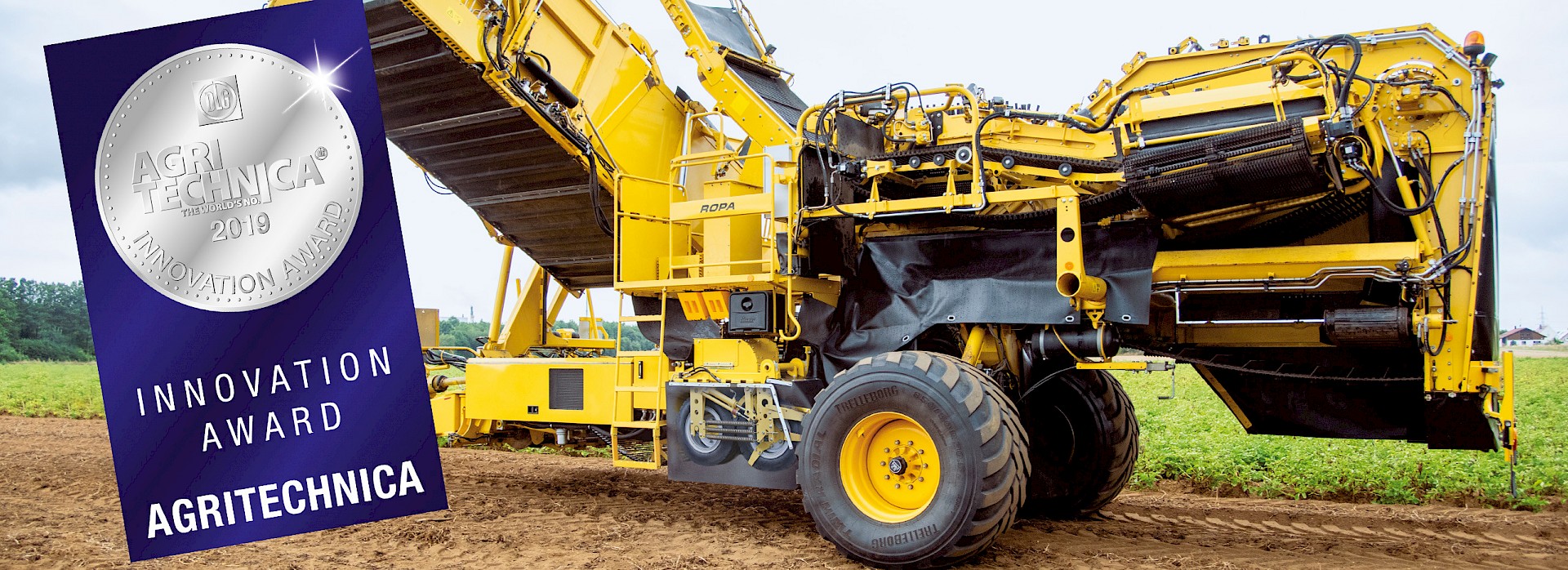Innovation: potato press in the ROPA Keiler 2 potato harvester
The ROPA potato press is the new, sustainable, herbicide-free, resource-sparing process for preventing secondary potato growth in secondary crops. The potato press crushes and grinds the tubers sorted out via the discharge chutes and trash track. This promotes decay and consistently prevents the germination of tubers the next year. At the Agritechnica Innovation Awards in Hannover, ROPA was awarded the silver medal. Agritechnica, which was held from November 10-16 in Hannover, is the world's leading trade show for agriculture and agricultural technology.
Preventing secondary growth potatoes
Undesired secondary potato growth in the next year's crop has become a central problem in many growing regions. Secondary potato growth undermines the location-oriented crop rotation and brings a multitude
of problems:
- uncontrolled source of diseases and pests, e.g. rhizoctonia, the phytophthora virus, nematodes, wireworms
- Direct competition for light, water, and nutrients, especially for cultures with slow early development
- More difficult harvesting of the next year's crop
- Endangering of the marketability (potato as companion planting, e.g. in vegetables)
- Increasing risk of type mixtures in all market segments
A primary cause of the increased occurrence of secondary potato growth is the most recent overly-mild winters. This situation has gotten worse due to current climate change, even in regions where frost was always a given. For frost damage to the tubers, a temperature of at least -2 °C for a period of 25 hours is required (rule of thumb 50 frost hours: 25 h*-2 °C or 17 h*-3 °C).
Source: Union der deutschen Kartoffelwirtschaft e.V., "Preventing secondary growth" flyer
Mechanical crushing against secondary growth potatoes
Most small potatoes are sorted out via the trash track. Similarly, rotten, greening or misshapen tubers are sorted out by harvesting personnel via the discharge chute or the trash track. All of the tubers sorted out are conveyed to the potato press.
The potato press crushes and grinds the tubers sorted out via the discharge chutes and trash track. Crushed potatoes have a much smaller volume and a larger surface area, which helps promote the planting process; a germination the next year is prevented!
How the potato press works
The potato press consists of two pneumatic wheels driven at different speeds
1 shredding blade of Hardox on a crushing tire
- Small pieces are beat off large potatoes until these are caught, crushed, and pressed by the pressing rollers
- Large clods are broken up into small pieces, caught, and also crushed
2 Hydraulic drive of the rubber wheels
- The wheels' different speeds increase the chopping effect by grinding during pressing
- The speeds can be adjusted variably with a quantity controller
3 Mechanical guard against stones and foreign bodies via spiral springs for pre-tensioning - for uninterrupted harvesting
How the ROPA potato press works and its benefits
The rubber wheels turning toward one another crush and grind the potatoes sorted out
1. Quantity controller for speed adjustment
2. Very quiet operation
- No direct contact of the pressing rollers
- The distance between the pressing rollers can be set variably with a spindle
Rubber tires as pressing rollers
- Low wear
- Little application of force
- Quiet and low-vibration running, even with more stones in the soil
- Variably adjustable air pressure in the wheels
Benefits of the potato press
- No or much-reduced use of herbicides for to fight secondary growth
- Better field hygiene thanks to interruption of the infection chain
- No undermining of location-oriented crop rotation
- Mechanical process, also suitable for organic agriculture
- Preventative system for type mixing
- No reduction of yield from the next year's crop due to plants competing for light, water, and nutrients
- No reduction of yield from the next year's crop due to side-effects of herbicides
- Time savings thanks to less checking of secondary growth
- No additional driving across the field required to make another pass
- Can be used in all potato-growing regions
- No compromising of machine performance
- No compromising or endangering of the harvest personnel
- Safe, robust system with little wear and low operating costs
Conclusion:
The ROPA potato press prevents secondary potato growth and makes chemical and mechanical measures to combat this unnecessary.
The ROPA potato press has successfully passed extensive practical tests and will be presented for the first time at Agritechnica. This innovation is available as an option for the ROPA Keiler starting in 2020.
PDF download:
INNOVATION: Potato press in the ROPA Keiler 2 potato harvester












